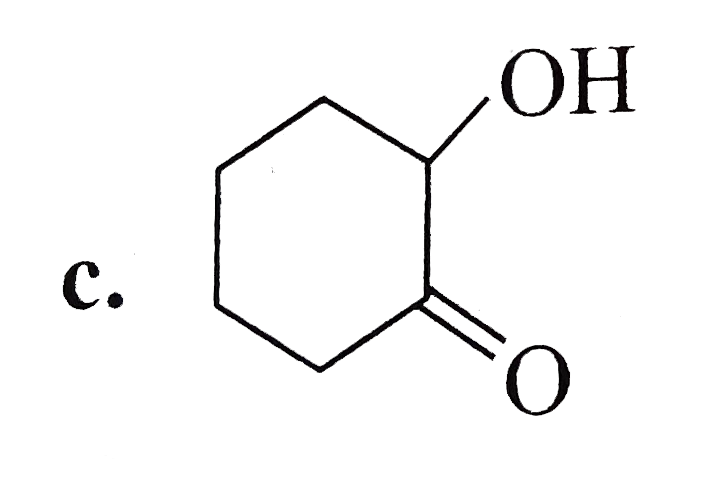Conpound (A)2molof−−−−−−→HIO42 mol of glyoxalic acid.
The compound (A) is:
a.
b.
c.
d.
The correct Answer is:D
To determine the compound (A) that reacts with 2 moles of HIO4 to produce 2 moles of glyoxalic acid, we can follow these steps:
Step 1: Understand the Reaction
HIO4 (periodic acid) is known to react with diols (compounds containing two hydroxyl groups -OH on adjacent carbons) through a mechanism called "syn addition." This means that both hydroxyl groups will be added to the same side of the molecule.
Step 2: Identify the Product
The product of the reaction is glyoxalic acid, which has the structure:
O∣∣H−C−C(OH)−C(OH)−H
Glyoxalic acid has two carbonyl groups (C=O) and two hydroxyl groups (OH).
Step 3: Determine the Structure of Compound (A)
Since the reaction consumes 2 moles of HIO4 and produces 2 moles of glyoxalic acid, compound (A) must have a structure that can yield two glyoxalic acid molecules upon oxidation.
The likely candidate for compound (A) is a 1,2-diol that can be oxidized to produce two molecules of glyoxalic acid. The simplest structure that fits this description is 1,2-ethanediol (ethylene glycol), which has the following structure:
HO−CH2−CH2−OH
Step 4: Reaction Mechanism
1. The two hydroxyl groups in 1,2-ethanediol are oxidized by HIO4.
2. The syn addition leads to the formation of intermediate structures that eventually rearrange to form glyoxalic acid.
3. The reaction results in the cleavage of the carbon-carbon bond and the formation of two molecules of glyoxalic acid.
Final Answer
Thus, the compound (A) that reacts with 2 moles of HIO4 to produce 2 moles of glyoxalic acid is 1,2-ethanediol (ethylene glycol).
---
HIO4 (periodic acid) is known to react with diols (compounds containing two hydroxyl groups -OH on adjacent carbons) through a mechanism called "syn addition." This means that both hydroxyl groups will be added to the same side of the molecule.
The product of the reaction is glyoxalic acid, which has the structure:
O∣∣H−C−C(OH)−C(OH)−H
Glyoxalic acid has two carbonyl groups (C=O) and two hydroxyl groups (OH).
Since the reaction consumes 2 moles of HIO4 and produces 2 moles of glyoxalic acid, compound (A) must have a structure that can yield two glyoxalic acid molecules upon oxidation.
HO−CH2−CH2−OH
1. The two hydroxyl groups in 1,2-ethanediol are oxidized by HIO4.
2. The syn addition leads to the formation of intermediate structures that eventually rearrange to form glyoxalic acid.
3. The reaction results in the cleavage of the carbon-carbon bond and the formation of two molecules of glyoxalic acid.
Thus, the compound (A) that reacts with 2 moles of HIO4 to produce 2 moles of glyoxalic acid is 1,2-ethanediol (ethylene glycol).
Topper's Solved these Questions
- REDUCTION AND OXIDATION REACTION OF ORGANIC COMPOUNDSBOOK - CENGAGE CHEMISTRYCHAPTER - REDUCTION AND OXIDATION REACTION OF ORGANIC COMPOUNDSEXERCISE - Exercise (Assertion And Reasoning)
10 Videos
- REDUCTION AND OXIDATION REACTION OF ORGANIC COMPOUNDSBOOK - CENGAGE CHEMISTRYCHAPTER - REDUCTION AND OXIDATION REACTION OF ORGANIC COMPOUNDSEXERCISE - Exercise Archives (Subjective)
26 Videos
- REDUCTION AND OXIDATION REACTION OF ORGANIC COMPOUNDSBOOK - CENGAGE CHEMISTRYCHAPTER - REDUCTION AND OXIDATION REACTION OF ORGANIC COMPOUNDSEXERCISE - Exercise (Multiple Correct)
35 Videos
- QUALITATIVE INORGANIC SALT ANALYSISBOOK - CENGAGE CHEMISTRYCHAPTER - QUALITATIVE INORGANIC SALT ANALYSISEXERCISE - Viva Voce Questions And Part-C (Analysis Of Cations)
42 Videos
- SOLID STATEBOOK - CENGAGE CHEMISTRYCHAPTER - SOLID STATEEXERCISE - Ex 1.2 (Objective)
9 Videos
Similar Questions
Identify A, B, and C.
A, B, and C(C6H10)Br2/CCI2−−−−−−→All decolourisesBr2solution
Cold−−−−−−−→conc.H2SO4 All are soluble
(A)Ammoniacal−−−−−−→AgNO3 White precipitate
(AandB)excess−−−−−→ofH2/Pt Hexane
(C)1mol−−−→H2/PtD(C6H12)
(A)Hotalk.−−−−→KMnO4 Pent anoic acid only
(B)Hotalk.−−−−→KMnO4 Propanoic acid only
(C)Hotalk.−−−−→KMnO4 Adipic acid only
View SolutionFeCr2O4+Na2CO3+O2Fusion−−−→[X]H+−−−−−→H2O[Y]H+−−−−−→H2O2[Z]
Which of the following statement is true for the compounds [X],[Y] and [Z] ?
View Solution
Knowledge Check
Compound (A)1molof−−−−−−→HIO4

The compound (A) is:Aa. Bb.
Bb. Cc.
Cc. Dd.
Dd.
A HCN−−→BH3O+−−−→2-Hydroxy propanoic acid, the compound B is :
ACH3CHOBAcetaldehyde cyanohydrinCFormaldehyde cyanohydrinDAcetoneCH3−CH2−C≡CHHgSO4−−−−−−→H2SO4 A, the compound A is
ACH3−CH2−O∣∣C−CH3BCH3−CH2−CH2−CHOCCH3−CH2−CH2−COOHDCH3CH2CH2CH2OH
In the following sequence of reactions, the products (A) to (G) are formed:
i. 2CH4(g)Δ−−−→1773K(A)(g)+B(g)
ii. 4molof(A)Δ−−−−−−−−−−→Ni(CN)4+THF(C)O3/oxid.−−−−−→(D)only
iii. (A)(1)1molofNaNH2−−−−−−−−−−−→(2)C2H5I(E)3molofE−−−−−−→RedhottubeF⏐↓O3/Red.(G)only
Compounds (A) and (B), respectively, are:
View SolutionRed precipitate Cu2Cl2←−−−−NH4OHP(C5H8)Ozonolysis−−−−−→2-Methylpropanoic acid + compound (Q) structure of P can be-
View SolutionC6H5(CH2)5O∣∣C−ClAlCl3−−→CS2(A)C12H14OKMnO4,D−−−−−−→H3O⊕(B), Compound (B) is:
View Solution2HC≡CHCH2Cl2−−−−−→+NH4Cl(A)1mol−−→HCl(B)
Compounds (A) and (B) are:
View Solution2ClCH2CH2OH(excess)Conc.H2SO4−−−−−−−→415KXKOH−−→FuseY
The compound Y is
View Solution